微观经济学期末试卷
长春大学《微观经济学》2023-2024学年第一学期期末试卷
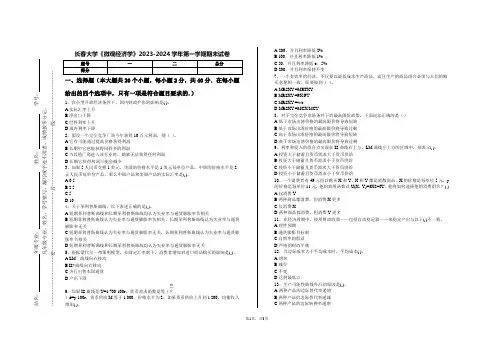
站名: 年级专业: 姓名: 学号:凡年级专业、姓名、学号错写、漏写或字迹不清者,成绩按零分记。
…………………………密………………………………封………………………………线…………………………长春大学《微观经济学》2023-2024学年第一学期期末试卷题号一 二 总分 得分一、选择题(本大题共20个小题,每小题2分,共40分.在每小题给出的四个选项中,只有一项是符合题目要求的.)1、在小型开放经济条件下,国内财政扩张的影响是( )。
A.实际汇率上升 B.净出口下降 C.世界利率上升 D.国内利率下降2、假设一个完全竞争厂商今年获得10万元利润,则( )。
A.它有可能通过提高价格获得利润 B.长期中它也能获得同样多的利润C.当其他厂商进入该行业时,她就无法获得任何利润D.长期它获得利润可能会减少3、如果5人民币交换1美元,美国的价格水平是1美元每单位产品,中国的价格水平是2元人民币每单位产品,那么中国产品和美国产品的实际汇率是( )。
A.0.5 B.2.5 C.5 D.104、关于菲利普斯曲线,以下表述正确的是( )。
A.短期菲利普斯曲线和长期菲利普斯曲线均认为失业率与通货膨胀率负相关B.短期菲利普斯曲线认为失业率与通货膨胀率负相关,长期菲利普斯曲线认为失业率与通货膨胀率无关C.短期菲利普斯曲线认为失业率与通货膨胀率无关,长期菲利普斯曲线认为失业率与通货膨胀率负相关D.短期菲利普斯曲线和长期菲利普斯曲线均认为失业率与通货膨胀率无关5、根据蒙代尔一弗莱明模型,在固定汇率制下,消费者增加对进口商品购买的影响是( )。
A.LM ’曲线向右移动 B.IS*曲线向右移动 C.央行出售本国通货 D.产出下降6、如果IS 曲线是Y=1 700-100r ,货币需求函数是等()d=y-100r ,货币供给M 等于1 000,价格水平为2。
如果货币供给上升到1 200,均衡收入增加( )。
A.200,并且利率降低2%B.100,并且利率降低1%C.50,并且利率降低o .5%D.200,并且利率保持不变7、一个有效率的经济,不仅要以最低成本生产商品,而且生产的商品组合必须与人们的购买意愿相一致,即要做到( )。
微观经济学期末考试测试题及答案
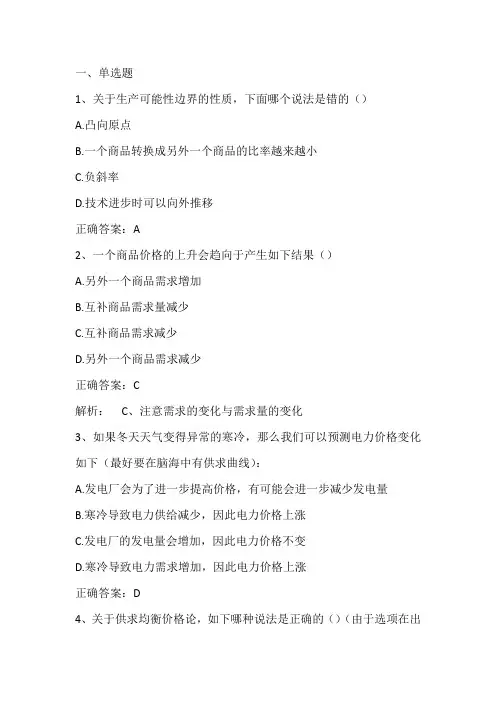
一、单选题1、关于生产可能性边界的性质,下面哪个说法是错的()A.凸向原点B.一个商品转换成另外一个商品的比率越来越小C.负斜率D.技术进步时可以向外推移正确答案:A2、一个商品价格的上升会趋向于产生如下结果()A.另外一个商品需求增加B.互补商品需求量减少C.互补商品需求减少D.另外一个商品需求减少正确答案:C解析:C、注意需求的变化与需求量的变化3、如果冬天天气变得异常的寒冷,那么我们可以预测电力价格变化如下(最好要在脑海中有供求曲线):A.发电厂会为了进一步提高价格,有可能会进一步减少发电量B.寒冷导致电力供给减少,因此电力价格上涨C.发电厂的发电量会增加,因此电力价格不变D.寒冷导致电力需求增加,因此电力价格上涨正确答案:D4、关于供求均衡价格论,如下哪种说法是正确的()(由于选项在出现时是随机排序的,请大家注意理解)A.虽然a是对的,但是存在着一些例外,有些因素是在供求之外影响到价格的B.a是对的,但是是针对均衡价格而言的,如果是非均衡价格,就和供给与需求无关了C.a.无论是什么因素对均衡价格的影响,都可以归结为供给方面,或需求方面,或供给与需求两方面D.均衡价格一旦形成,就绝不会再改变,无论外在条件发生了什么变化正确答案:C5、在一个加油站,汽油价格每天都在变化之中。
一个司机过来后,没有看价格就直接说,给我加40升的汽油()A.司机的需求价格弹性为单位弹性B.司机对汽油的需求是完全弹性的C.司机的需求价格弹性为零D.司机对汽油的需求价格弹性为无限大正确答案:C6、已知需求方程为D=M/P(M为任意常数),那么()A.这种需求的需求价格弹性为单位弹性B.因为需求价格弹性与斜率成反比,所以需求曲线上左边的点的需求价格弹性较小C.因为需求曲线上左边所对应的价格较高,所以需求曲线上左边的点所对应的需求价格弹性较大D.这种需求函数属于线性需求函数正确答案:A7、已知需求方程为D=A/P,关于其需求价格弹性,如下事实成立:A.需求价格弹性绝对值随着价格上升先上升后下降B.需求价格弹性绝对值随着价格上升而上升C.需求价格弹性绝对值总是等于1D.需求价格弹性绝对值随着价格上升而下降正确答案:C8、关于需求的交叉价格弹性:A.弹性为负意味着两商品的互补关系B.对任意两个商品而言,弹性不可能为零C.弹性为负意味着两商品的替代关系D.弹性为正意味着两商品的互补关系正确答案:A9、已知供给方程为S=20P,其供给弹性为:A.-1B.1C.20D.依价格而定正确答案:B10、关于序数效用理论,如下哪些说法是正确的?A.如果(X,Y)的效用是(4,1),那有可能是因为X的价格比Y的价格要低B.其余说法全错C.如果(X,Y)的效用是(4,1),那就意味着,X和Y的效用都非常小D.如果(X,Y)的效用是(4,1),我们就说X的效用是Y的效用的4倍正确答案:B11、边际替代率如果用MRS表示的话,我们有两个公式成立:公式1:MRS=MUX/MUY,公式2:MRS=∆Y/∆X。
微观经济学期末考试试题
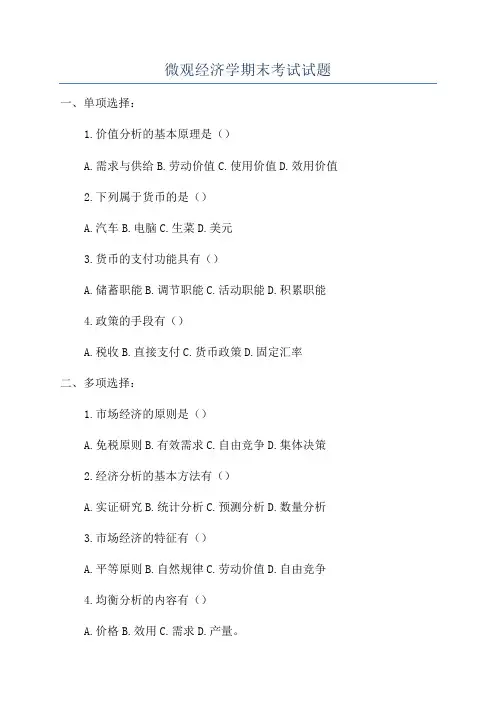
微观经济学期末考试试题
一、单项选择:
1.价值分析的基本原理是()
A.需求与供给
B.劳动价值
C.使用价值
D.效用价值
2.下列属于货币的是()
A.汽车
B.电脑
C.生菜
D.美元
3.货币的支付功能具有()
A.储蓄职能
B.调节职能
C.活动职能
D.积累职能
4.政策的手段有()
A.税收
B.直接支付
C.货币政策
D.固定汇率
二、多项选择:
1.市场经济的原则是()
A.免税原则
B.有效需求
C.自由竞争
D.集体决策
2.经济分析的基本方法有()
A.实证研究
B.统计分析
C.预测分析
D.数量分析
3.市场经济的特征有()
A.平等原则
B.自然规律
C.劳动价值
D.自由竞争
4.均衡分析的内容有()
A.价格
B.效用
C.需求
D.产量。
《微观经济学》期末测试题及答案
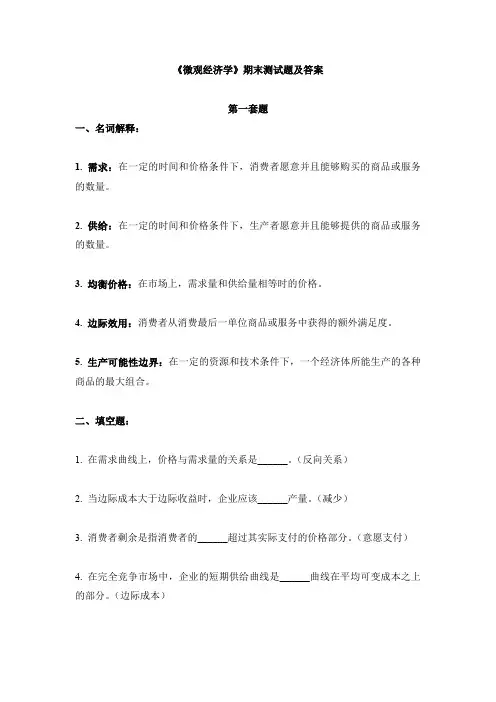
《微观经济学》期末测试题及答案第一套题一、名词解释:1. 需求:在一定的时间和价格条件下,消费者愿意并且能够购买的商品或服务的数量。
2. 供给:在一定的时间和价格条件下,生产者愿意并且能够提供的商品或服务的数量。
3. 均衡价格:在市场上,需求量和供给量相等时的价格。
4. 边际效用:消费者从消费最后一单位商品或服务中获得的额外满足度。
5. 生产可能性边界:在一定的资源和技术条件下,一个经济体所能生产的各种商品的最大组合。
二、填空题:1. 在需求曲线上,价格与需求量的关系是______。
(反向关系)2. 当边际成本大于边际收益时,企业应该______产量。
(减少)3. 消费者剩余是指消费者的______超过其实际支付的价格部分。
(意愿支付)4. 在完全竞争市场中,企业的短期供给曲线是______曲线在平均可变成本之上的部分。
(边际成本)5. _____是市场经济中最基本的价格决定机制。
(供求机制)三、单项选择题:1. 下列哪种情况会导致需求曲线向右移动?(B)A. 商品价格上升B. 消费者收入增加C. 替代品价格下降D. 商品的生产成本增加2. 当市场价格低于均衡价格时,市场上会出现(C)。
A. 供大于求B. 供求平衡C. 供不应求D. 不确定3. 在生产者理论中,当边际收益小于边际成本时,生产者应(A)。
A. 减少产量B. 增加产量C. 保持产量不变D. 关闭生产4. 市场经济中,资源配置的主要方式是通过(D)。
A. 政府计划B. 行业协会规定C. 企业自主决策D. 价格机制5. 下列哪种市场结构中,企业具有最大的定价能力?(D)A. 完全竞争市场B. 垄断竞争市场C. 寡头垄断市场D. 完全垄断市场四、多项选择题:1. 下列哪些因素会影响需求?(ABCD)A. 消费者收入B. 商品价格C. 相关商品的价格D. 消费者的偏好2. 下列哪些情况下,企业的供给曲线会向右移动?(AC)A. 生产技术进步B. 生产成本增加C. 原材料价格下降D. 政府提高税收3. 下列关于边际效用的说法正确的是?(BC)A. 边际效用总是递增的B. 边际效用可能为负C. 总效用达到最大时,边际效用为零D. 边际效用不能用于衡量消费者的总满足度4. 市场失灵的原因可能包括?(ABCD)A. 公共物品的存在B. 外部性的影响C. 垄断的存在D. 信息不对称5. 下列哪些市场结构中,企业可以设定价格?(AD)A. 完全垄断市场B. 完全竞争市场C. 垄断竞争市场D. 寡头垄断市场五、判断题:1. 如果一种商品的需求价格弹性大于1,那么该商品是必需品。
《微观经济学》期末考试题
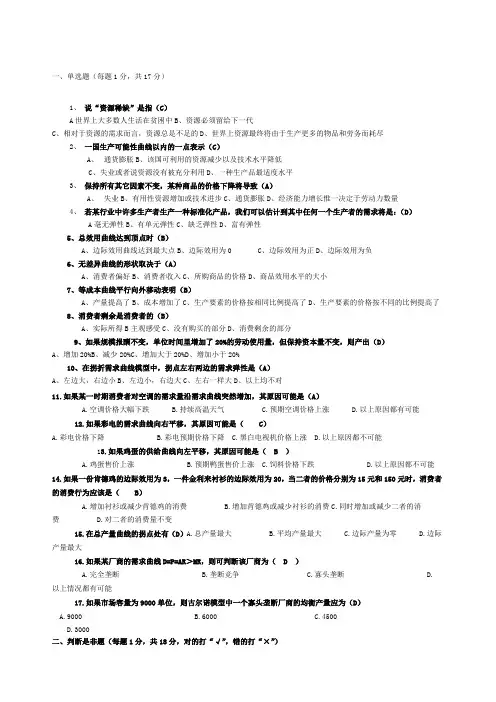
一、单选题(每题1分,共17分)1、说“资源稀缺”是指(C)A世界上大多数人生活在贫困中B、资源必须留给下一代C、相对于资源的需求而言,资源总是不足的D、世界上资源最终将由于生产更多的物品和劳务而耗尽2、一国生产可能性曲线以内的一点表示(C)A、通货膨胀B、该国可利用的资源减少以及技术水平降低C、失业或者说资源没有被充分利用D、一种生产品最适度水平3、保持所有其它因素不变,某种商品的价格下降将导致(A)A、失业B、有用性资源增加或技术进步C、通货膨胀D、经济能力增长惟一决定于劳动力数量4、若某行业中许多生产者生产一种标准化产品,我们可以估计到其中任何一个生产者的需求将是:(D)A毫无弹性B、有单元弹性C、缺乏弹性D、富有弹性5、总效用曲线达到顶点时(B)A、边际效用曲线达到最大点B、边际效用为0C、边际效用为正D、边际效用为负6、无差异曲线的形状取决于(A)A、消费者偏好B、消费者收入C、所购商品的价格D、商品效用水平的大小7、等成本曲线平行向外移动表明(B)A、产量提高了B、成本增加了C、生产要素的价格按相同比例提高了D、生产要素的价格按不同的比例提高了8、消费者剩余是消费者的(B)A、实际所得B主观感受C、没有购买的部分D、消费剩余的部分9、如果规模报酬不变,单位时间里增加了20%的劳动使用量,但保持资本量不变,则产出(D)A、增加20%B、减少20%C、增加大于20%D、增加小于20%10、在拐折需求曲线模型中,拐点左右两边的需求弹性是(A)A、左边大,右边小B、左边小,右边大C、左右一样大D、以上均不对11.如果某一时期消费者对空调的需求量沿需求曲线突然增加,其原因可能是(A)A.空调价格大幅下跌B.持续高温天气C.预期空调价格上涨D.以上原因都有可能12.如果彩电的需求曲线向右平移,其原因可能是(C)A.彩电价格下降B.彩电预期价格下降C.黑白电视机价格上涨D.以上原因都不可能13.如果鸡蛋的供给曲线向左平移,其原因可能是( B )A.鸡蛋售价上涨B.预期鸭蛋售价上涨C.饲料价格下跌D.以上原因都不可能14.如果一份肯德鸡的边际效用为3,一件金利来衬衫的边际效用为20,当二者的价格分别为15元和150元时,消费者的消费行为应该是(B)A.增加衬衫或减少肯德鸡的消费B.增加肯德鸡或减少衬衫的消费C.同时增加或减少二者的消费 D.对二者的消费量不变15.在总产量曲线的拐点处有(D)A.总产量最大 B.平均产量最大 C.边际产量为零 D.边际产量最大16.如果某厂商的需求曲线D=P=AR>MR,则可判断该厂商为( D )A.完全垄断B.垄断竞争C.寡头垄断D.以上情况都有可能17.如果市场容量为9000单位,则古尔诺模型中一个寡头垄断厂商的均衡产量应为(D)A.9000B.6000C.4500D.3000二、判断是非题(每题1分,共18分,对的打“√”,错的打“×”)1、经济学是研究怎样优化配置资源的科学。
2024年微观经济学期末试题附答案(精选)
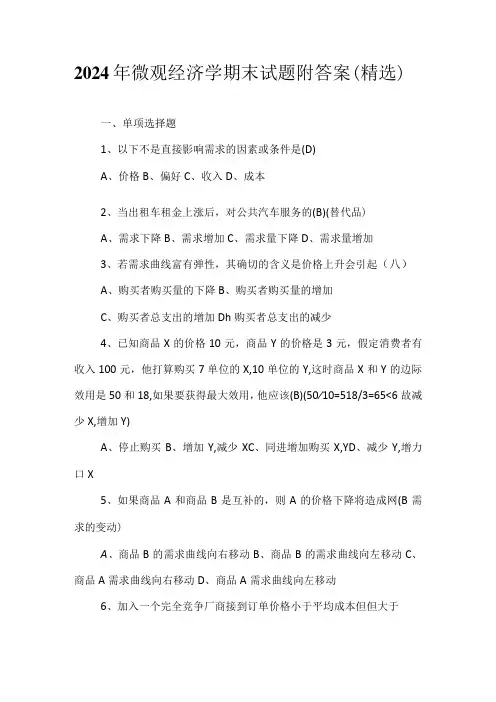
2024年微观经济学期末试题附答案(精选)一、单项选择题1、以下不是直接影响需求的因素或条件是(D)A、价格B、偏好C、收入D、成本2、当出租车租金上涨后,对公共汽车服务的(B)(替代品)A、需求下降B、需求增加C、需求量下降D、需求量增加3、若需求曲线富有弹性,其确切的含义是价格上升会引起(八)A、购买者购买量的下降B、购买者购买量的增加C、购买者总支出的增加Dh购买者总支出的减少4、已知商品X的价格10元,商品Y的价格是3元,假定消费者有收入100元,他打算购买7单位的X,10单位的Y,这时商品X和Y的边际效用是50和18,如果要获得最大效用,他应该(B)(50∕10=518/3=65<6故减少X,增加Y)A、停止购买B、增加Y,减少XC、同进增加购买X,YD、减少Y,增力口X5、如果商品A和商品B是互补的,则A的价格下降将造成网(B需求的变动)A、商品B的需求曲线向右移动B、商品B的需求曲线向左移动C、商品A需求曲线向右移动D、商品A需求曲线向左移动6、加入一个完全竞争厂商接到订单价格小于平均成本但但大于平均可变成本,它应该是(C)A、停止生产B、生产且有利润C、亏损但继续生产D、生产且利润为零7、如果价格下降10%能使买者总支出增加10%,则这种商品的需求量对价格(八)A、富有弹性B、具有单位弹性C、缺乏弹性D、其弹性不能确定8、已知XY两种商品的交叉弹性一-0.4,则这两种商品是(C)A、独立品B、替代品C、补充品D、不能确定交叉弹性大于0,即是替代品,交叉弹性等于0,即是无相关,交叉弹性小于0,即是互补品9、在完全竞争市场中,厂商短期均衡条件是(C)(MR=SMC)A、P=ARB、P=MRC>P=MCD、P=AC10、市场均衡意味着(D)A、在某价格水平上供给数量等于需求数量B、在均衡价格水平上,每一个买者都可以买到想买的数量,每一个卖者都可以卖出想卖的数量C、价格没有变动的趋势D、上述答案均正确11、市场失灵是指(八)A、市场不能有效配置稀缺资源B、市场完全不好C、收入分配不均D、资源在私人部门和公共部门配置不均12、如果上游工厂污染了下游居民的饮水,按科斯定理(B),问题就可以妥善解决A、不管产权是否明确,只要交易成本为零B、只要产权明确,且交易成本为零C、只要产权明确,不管交易成本多大D、不论产权是否明确,交易成本是否为零13、市场不能提供纯粹公共产品是由于:(D)A、公共产品不具有竞用性B、公共产品不具有排他性C、消费者都想免费搭车D、以上三种情况都是14、吉芬商品表现为(B)A、需求收入弹性和需求价格弹性都是正值B、需求收入弹性为负,需求价格弹性为正C、需求收入弹性为正,需求价格弹性为负D、需求收入弹性和需求价格弹性都是负值15、若一种商品的消费量随着消费者收入的增加而减少,一般来说,改商品是(D)A、正常品B、奢侈品C、必需品D、劣质品二、作图分析说明题1、作图说明赋税是如何造成经济剩余的无谓损失2、作图说明利率提高是何增加或是减少家庭储蓄的两种图型,并做一定的分析三、简答题1、影响需求价格弹性大小的因素有哪些?答:相近替代品的可获得性;必需品与奢侈品;市场的定义;时间框2、外部性的私人解决方法的类型及其并不总是有效的原因?答:类型:用道德规范和社会约束来解决;慈善行为;利益各方签订合约;依靠有关各方的利己来解决不总是有效的原因:交易成本;固执;协调问题四、名词解释机会成本,是把该资源投入某一特定用途以后,所放弃的在其他各种可能的用途中所能获得的最大收益。
微观经济学期末考试试卷(含答案)全解
西方经济学(微观部分)期末考试试卷(A卷)考试科目:微观经济学考试类型:(闭卷)考试时间:120 分钟学号姓名年级专业一、单项选择题(每题0.5分,共15分,将正确答案填入答题纸上)1.看不见的手一般指()A、机会成本B、政府C、利润D、价格2.经济学中的“稀缺性”是指()A 世界上大多数人生活在贫困中B、相对于资源的需求而言,资源总是不足的C用资源必须考虑下一代 D、世界上的资源终将被人类消耗光3.如果x与y商品是互补品,x价格下降,将使y()A、需求量增加B、需求增加C、需求量减少D、需求减少4.冰棒的需求价格弹性()药品的需求价格弹性A、大于B、小于C、等于D、大于或等于5.下列命题中哪个是规范经济学的命题?( )A.征税对中等收入家庭是不公平的B. 1982年8月政府把贴现率降到10%C. 1981年失业率超过9%D.社会保险税的课税依据现已超过30000美元6.如果消费者的预算收入为50美元,商品X和Y的价格均为5美元,消费者打算购买6单位X和4单位Y,商品X、Y的边际效用分别为25和20,那么,要达到效用最大化,他应该()A、按原计划购买B、减少X和Y的购买量C、增加X、Y的购买量D、增加X的同时减少Y的量7.消费者预算线发生平移时,连接消费者均衡点的曲线称为()A、需求曲线;B、价格-消费曲线;C、收入-消费曲线;D、恩格尔曲线。
8.当某人面对一张彩票时,如果是212111UW P W PU W P PW U )()(])([-+〈-+,则意味着这个人是属于下列哪一类人 ( )A .风险回避者B .风险喜爱者C .风险中立者D .都不是9.如果某厂商增加一单位劳动使用量能够减少三单位资本,而仍生产同样的产出量,则MRTS LK 为:( )A 1/3B 3C -3D 610. MC 曲线达到最低时( )A MP 最大B AVC 最小C TC 最大D AC 最小11.某厂商每年从企业的总收入中取出一部分作为自己所提供的生产要素的报酬,这部分资金被视为( )。
大学微观经济学期末常考高分试题(有答案)
一、 单项选择题(共10题,每题2分,共20分)1、政府对读者出售的商品每单位征税5元,假定这种商品的需求价格弹性为零,可以预料价格的上升( B ) B .等于5美元2、小麦欠收导致小麦价格上升,准确地说在这个过程中( A )A. 小麦供给的减少引起均衡数量下降。
3、下列哪种情况不属于消费者均衡的条件( D )A 、λγγ===....P MU P MU X X B 、货币在每种用途上的边际效用相符。
C 、MU=P λ、 D 、各种商品的边际效用相等.4、 Un 下列哪项不属于完全垄断的原因( D )A 、 专利B 资源控制C 规模经济。
D 超额利润5、下列说法中正确的( D )D 、生产要素的边际技术替代率递减是边际报酬递减规律造成的。
6、等产量曲线( A )A 、 说明为了生产一个给定的产量而可能的各种要素投入组合.7、一般来说,经济成本和经济利润具有以下特征( A )A 、 前者比会计成本大,后者比会计利润小.8、长期和短期的区别在于( B )B 、长期中所有的要素投入都可变,而短期中至少有一种要素投入数量不变。
9、如果在完全竞争厂商的短期均衡数量上,P 小于SAC ,但大于AVC ,则厂商( B ) B 亏损,但继续生产。
10、完全竞争的成本递减行业的长期供给曲线是( D )A 、 水平直线。
B 自左下向右上倾斜。
C 垂直于横轴。
D 自左上向右下倾斜。
11、在得出某种商品的个人需求曲线时,下列因素除( D )外均保持为常数。
A 、个人收入B 、其余商品的价格C 、个人偏好D 、该商品的价格12、如果商品A 和商品B 是替代的,则A 的价格下降将造成( D )D 、B 的需求曲线向左移动13、若X 和Y 两产品的需求的交叉价格弹性是-1,则( D ) D 、X 和Y 是互补品14、某商品价格从10元下降到9元,需求量从70增至75,该商品需求( A )A 、缺乏弹性15、总效用曲线达到最大时,( B )B 、边际效用为零16、无差异曲线为斜率不变的直线时,表示相结合的两种商品是( B ) B 、完全替代的17、某无差异曲线是条水平直线,这表明消费者( B )的消费已达到饱和(设X 由横轴度量,Y 由纵轴度量) A 、商品X B 、商品Y C 、商品X 和Y D 、商品X 或Y18、已知消费者的收入是100元,商品X的价格是10元,商品Y的价格是3元,假定他打算买7单位X和10单位Y,这是商品X和Y的边际效用分别是50和18.如果他获得最大效用,他应该( C )A、停止购买B、增购X,减少Y的购买量C、减少X的购买量,增购YD、同时增购X和Y19、恩格尔曲线是从( B)导出 B、收入—消费曲线20、在总产量、平均产量和边际产量的变化过程中,下列(A)首先发生A、边际产量下降21、对于图所示的等产量线,下列说法错误的是( C )A、规模报酬不变B、固定比例生产函数C、L和K之间可以完全替代D、L与K边际技术替代率为零22、如果一项投入品的平均产量高于其边际产量,则( D )D、平均产量将随收入的增加而降低23、,某厂商每年从自己企业的总收入中取出一部分作为自己所提供的生产要素的报酬,这部分资金被视为( B ) A、显成本 B、隐成本 C、经济利润 D、超额利润24、一般来说,经济成本和经济利润具有以下特征( A)A、前者比会计成本大,后者比会计利润小25、短期内在每一产量上的SMC值应该( C)C即使该产量上的TVC曲线的斜率,又是该产量上的STC曲线的斜率26、完全竞争厂商所面临的需求曲线是一条水平线,它表示( B )B、厂商只能接受市场价格27、完全竞争厂商的短期供给曲线应该是( C)C、SMC曲线上停止营业点和超过停止营业点以上的部分28、在完全竞争市场中,行业的长期供给曲线取决于( C)C、LAC曲线最低点的运行轨迹29、完全垄断厂商的产品需求弹性为1时,(B )B、总收益最大30、下列哪一项不是进入一个垄断行业的壁垒( A)A、垄断利润二、辨析题(共4题,每题5分,共20分)1、当商品的需求价格弹性(绝对值)小于1时,降低售价会使收益增加( N )降低售价会使收益增加的是商品是需求弹性绝对值(也即富有弹性的商品)大于1的商品。
微观经济学试卷及答案
经济学院第一学期期末考试《微观经济学》试卷(A )一、选择题(下列每题只有一个正确答案,请将正确答案的序号填写在答题纸相应的空格中.每题1分,共15分)1.就皮鞋和皮包生产者而言,皮鞋价格的上涨将导致( )A.皮包供给的下降B.皮包供给曲线上点的移动C.皮鞋需求曲线的移动D.皮鞋供给曲线与皮包供给曲线均左移2.经济学中短期和长期的划分取决于()A.时间长短B.可否调整产量C.可否调整价格D.可否调整生产规模3.同一条无差异曲线上的不同点表示()A.效用水平不同,但所消费的两种商品组合比例相同B.效用水平相同,但所消费的两种商品的组合比例不同C.效用水平不同,两种商品的组合比例不相同D.效用水平相同,两种商品的组合比例相同4.下列行业中最接近完全竞争市场模式的是()A.飞机B.卷烟C.水稻D.汽车5.在完全竞争长期均衡中,如果企业成本不变,市场供给量的增加()A.全部来自原有企业B.全部来自新增企业C.部分来自原有企业,部分来自新增企业D.以上三种情况都有可能6.在完全价格歧视下,()A.需求曲线变成了边际收益曲线B.需求曲线变成了总收益曲线C.边际成本曲线变成了边际收益曲线D.边际成本曲线变成了总收益曲线7.当生产的产品价格上升时,作为在竞争性市场中一个追求利润最大化的厂商而言,对劳动的需求曲线将()A.左移B.右移C.变平坦D.不受影响8.下列各种成本中,哪条成本曲线的变动规律是向右下方倾斜( )A.平均固定成本B.平均可变成本C.短期边际成本D.短期总成本9.厂商在短期均衡产量上,如果AR小于SAC,但大于A VC,则厂商()A.亏损,但继续生产B.亏损,立即停产C.获利,继续生产D.亏损,生产与否都可10.下列关于洛伦兹曲线和基尼系数的论述,错误的是()A.洛伦兹曲线弯曲程度越大,基尼系数越大B.基尼系数越大,说明收入分配越不公平C.洛伦兹曲线越靠近对角线,说明基尼系数越大D.洛伦兹曲线和基尼系数都是描述收入分配公平程度的指标11.商品X、Y的价格按相同的比例上升,而收入不变,预算线( )A.向左下方平行移动B.向右下方平行移动C.不变动D.转动12.生产可能性边界图形的轴线用于衡量()A.生产性投入或资源的数量B.产成品的数量C.产成品的价值D.上述答案均正确13.如果边际成本在一定产量范围内大于平均成本,则在该范围内,产量的增加都将促使平均成本( )A.升高B.降低C.升高或降低取决于可变成本的变化D.保持不变14.假定某歌唱演员的年薪为10万元,但他(她)从事其他职业最多只能得到3万元,则这个演员所获得的经济租金为()A.10万元B.3万元C.7万元D.13万元15.帕累托最优配置是指( )A.总产量达到最大B.边际效用达到最大C.消费者得到他们想要的所有东西D.没有一个人可以在不使任何他人境况变坏的条件下使得自己境况变得更好二、判断题(在答题纸相应的空格中,正确的打“√”,错误的打“×”.每题1分,共10分)16.供给量是指在某一价格下,生产者愿意生产并且能够卖出去的数量。
《微观经济学》期末考试题及参考答案
《微观经济学》期末考试题及参考答案一、单项选择题(每小题1分,共15分)1.短期生产函数的短期是指()。
A.一年以内B.半年以内C.与具体时间长短无关D.时间非常短2.完全竞争市场厂商的总收益曲线是()。
A.以不变的斜率向上倾斜B.水平C.以不变的斜率向下倾斜D.垂直3.媒体刊登了一种补肾的“薏米山药粥”,配料是“薏米100克,山药200克,玫瑰花5克,大枣20克,冰糖适量”。
该条信息将会()。
A.使薏米的需求量增加B.使薏米的需求增加C.不一定,需求增加,供给也会增加D.使薏米的价格上升4.如果一个企业经历规模报酬不变阶段,则LAC曲线是()。
A.上升的B.下降的C.垂直的D.水平的5.不完全竞争的企业面对着向下倾斜的需求曲线,这意味着()。
A.它们对价格有一定程度的控制能力B.它们对价格有完全的控制能力C.它们不能控制价格D.需求是完全有弹性的6.如果等成本线在坐标平面上与等产量线相交,那么要生产等产量曲线表示的产量水平()。
A.还可以减少成本支出B.不能再减少成本支出C.应该再增加成本支出D.上述都不正确7.如果在需求曲线上有一点,ed=4,P=12元,则MR等于()。
A .30元B. 20元C. 9元D .15元8.微观经济学是经济学的一个分支,主要研究()。
A.市场经济B.个体行为C.总体经济活动D.失业和通货膨胀等9.由企业购买或租用任何生产要素所发生的成本是指( )。
A.显性成本B.隐性成本C.变动成本D.固定成本10.当一个完全竞争行业实现长期均衡时,每个企业()。
A.都实现了正常利润B.利润都为零C.行业中没有任何厂商再进出D.以上说法都对11.完全竞争企业在长期均衡状态下,成本不变的行业中,产量的增加量()。
A.完全来自新企业B.完全来自原有企业C.要么来自原有企业,要么来自新企业D.部分来自新企业,部分来自原企业。
12.假定X、Y的价格PX、PY已定,当MRSXY>PX/PY时,消费者为达到最大满足,他将()。
- 1、下载文档前请自行甄别文档内容的完整性,平台不提供额外的编辑、内容补充、找答案等附加服务。
- 2、"仅部分预览"的文档,不可在线预览部分如存在完整性等问题,可反馈申请退款(可完整预览的文档不适用该条件!)。
- 3、如文档侵犯您的权益,请联系客服反馈,我们会尽快为您处理(人工客服工作时间:9:00-18:30)。
汕头大学2008 至 2009学年第一学期《微观经济学》试卷学院年级姓名学号分数评卷 Part I. Multiple choice (1 points per each, 20 points in total)1. The demand curve for color TV sets might shift to the left because ( C ).A. The price of color TV sets increasesB. The price of black-and-white TV sets increasesC. Consumers expect that the price of color TV sets will fallD. Consumers’ income increases2. Among the following cost curves, ( B ) is NOT U-shaped.A. Average Variable CostB. Average Fixed CostC. Average Total CostD. Marginal Cost3. In terms of market structure, ( D ) is close to perfectly competitive market.A. AutomobileB. CigaretteC. NewspaperD. Agricultural produce4. At the optimal output level of monopolists, ( A ).A. MR = MCB. P = MCC. Price = the minimum of A VCD. Price is the highest5. If you exhibit the endowment effect as a decision maker, then you are ( C )A. deciding on the basis of sunk costs.B. buying something you can't really afford because you expect to save in the future.C. ignoring opportunity costs.D. consuming based on celebrity endorsements.6. One limitation of the Coase Theorem is that ( D ).A. it is valid only when there are many producersB. it is valid only when there are many consumersC. it is valid only when property system is well establishedD. it is not valid when transaction costs are high7. Which of the following is correct about a simple circular flow model? ( C )A. Producers are neither buyers nor sellers in the product market.B. Households are sellers in the product market.C. Producers are buyers in the factors market.D. None of these are correct.8. A firm will shut down in the short run if the price is below ( A ).A. Average variable costB. Average total costC. Average fixed costD. Marginal cost9. In terms of dividing the tax burden, consumers (not producers) will pay the tax if ( C ).A. price elasticity of supply and price elasticity of demand are both very largeB. price elasticity of supply is close to zeroC. price elasticity of demand is close to zeroD. price elasticity of supply and price elasticity of demand are similar10. The ultimate purpose of patents and copyrights is to ( D )A. provide owners with large profit forever.B. protect firms from being taken advantage of by competing firms.C. protect domestic firms from foreign competition.D. encourage the expenditure of funds on research and development to create new products.11. The substitution effect results in ( D )A. sellers substituting less expensive inputs in production.B. buyers buying more of a good because their purchasing power has increased.C. sellers producing products when input prices fall.D. buyers buying more of a relatively cheaper good.12. A cartel whose members adhere to the agreement is typically able to ( B )A. break even.B. earn large profits.C. entirely avoid competitive forces.D. produce a large amount of output.13. Businesses feel that slowly rising general prices are good for business because ( A )A. demand is kept strong because buyers expect prices to be higher in the future.B. the price of substitute goods must be rising faster.C. prices are rising slowly means buyers incomes must also be rising, so demand will increase.D. tastes are moving in a positive direction for goods whose prices are rising.14. Producers lobby the government to convince law makers to impose a price floor, so that they might ( B )A. charge consumers more than consumers are willing to pay.B. receive a larger producers surplus.C. receive a larger consumers surplus.D. hire workers for less than they would otherwise have to pay.15. The minimum wage is an example of ( C )A. a competitive equilibrium price.B. a price ceiling.C. a price floor.D. a tax on a market.16. The production possibilities frontier shows ( B )A. the various products that can be produced now and in the future.B. attainable combinations of two products that may be produced in a particular time period with available resources.C. what an equitable distribution of products among citizens would be.D. what people want to have produced in a particular time period.17. If 20 units are sold at a price of $50 and 30 units are sold at a price of $40, then the elasticity of demand calculated using the midpoint formula is ( B )A. minus 0.56.B. minus 1.8.C. minus 1.D. 1.18. Among those who benefit from free trade are ( A )A. the people of a country as a whole.B. each firm in the country.C. each person in the country.D. all of the above.19. Consumers pay 100% of a new sales tax on a good ( D )A) always.B) when demand is horizontal.C) never as the tax is on the seller.D) when the demand curve is vertical.20. A primary difference between a sole proprietorship and a partnership is ( C )A. sole proprietorships have unlimited liability while partnerships have limited liability.B. partnerships can issue stocks and bonds while sole proprietorships cannot.C. partnerships have more owners than do sole proprietorships.D. sole proprietorships have more layers of management than partnerships.●Part II. Term explanation (2 points per each, 20 points in total)1. Public GoodsA good that is both nonrivalrous and nonexcudable.2. OligopolyA market structure in which a small number of interdependent firms compete.3. Economies of ScaleEconomies of scale exists when a firm’s long-run average costs fall as it increases output.4. ExternalitiesA benefit or cost that affects someone who is not directly involved in the production or consumption of a good or service.5. Nash EquilibriumA situation where each firm chooses the best strategy, given the strategies chosen by other firms.6. Natural MonopolyA situation in which economics of scale are so large that one firm can supply the entire market at a lower average total cost than two or more firms.7. Indifference curveA curve that shows the combination of consumption bundles that give the consumer the same utility.8. Deadweight lossThe reduction in economic surplus resulting from a market not being in competitive equilibrium.9. Consumer SurplusThe difference between the highest price a consumer is willing to pay and the price the consumer actually pays.10. Comparative advantageThe ability of an individual, firm, and country to produce a good or service at a lower opportunity cost than other producers.●Part III. Answer Problems (5 points per each, in total 40 points)1. What makes a firm successful in a competitive market?The factors under a firm’s control—the ability to differentiate its product and the ability to produce it at lower cost (referring to the value created relative to competing firms)—combine with the factors beyond its control such as factors affecting the firm’s market and chance events to determine the firm’s profitability.2. Define rivalry and excludability and use these terms to discuss the four categories of goods.Rivalry occurs when one person’s consuming a unit of a good means that no one else can consume it. Excludability occurs when anyone who doesn’t pay for a good cannot consume it. Rival-excludable goodsare called private goods, which comprise most of the goods we consume. Rival-nonexcludable goods are called common resources – such as fish in the sea. Nonrival-nonexcludable goods are called public goods. Nonrival-excludable goods are often called natural monopolies.3. Is zero economic profit inevitable in the long run?No. The key to earning economic profit is either to sell a differentiate product or to find a way of producing an existing product at a lower cost.4. Why do economists refer to the pricing strategies of oligopoly firms as prisoners’ dilemma game?A prisoners’ dilemma is a game in which pursuing dominant strategies results in noncooperation that leaves everyone worse off. The outcome of noncooperative pricing (competition) will leave firms worse off than if they cooperated and set higher prices.5. Suppose that a perfectly competitive industry becomes a monopoly. Describe the effects of this change on consumer surplus, producer surplus, and market efficiency.If a perfectly competitive industry is monopolized, the price will rise and the quantity produced will fall. Consumer surplus will fall, producer surplus will rise and a deadweight loss will arise.6. What are the main sources of comparative advantage?The main sources of comparative advantage include climate and natural resources, the relative abundance of various types of labor and capital, technology and know-how, and external economies – reductions in a firm’s costs that result from an expansion in the size of the industry.Part IV. Case Study (10 points per each, in total 20 points)1. A music show is set to take place in a big stadium in Shanghai. The stadium can host 10,000 people. The organizer had carefully calculated the cost. A few pop music stars will show up. With the celebrity endorsements, at least 6000 tickets will be sold out. The revenue from 4800 tickets is sufficient to cover the cost and to break even. So the show is certainly to have profit.What is the marginal revenue? What is the marginal cost? What is the optimal level of audience?Answer: Marginal revenue is the income from an extra ticket sold. Marginal cost is zero, provided that the stadium is not full yet. The optimal level of audience is 10,000, the maximum capacity of the stadium.2. Price floor in labor markets. The minimum wage.The US congress has set a national minimum wage of 5.15 per hour for most occupations. It is illegal for an employer to pay less than this wage in those occupations. For most workers, the minimum wage is irrelevant because it is well below the wage that employers are voluntarily willing to pay them. But for low-skilled workers (such as workers in fast-food restaurants), the minimum wage is above the wage they would otherwise receive. What is the effect of the minimum wage on employment on the market for low-skilled labor?Answer: Because the minimum wage is higher than the equilibrium wage, the quantity of low-skilled workers demanded employers declines while the quantity of workers supplied increases, leading to surplus of workers unable to find jobs; that is, the unemployment increases. This makes a reduction in consumer surplus.3. When to close a laundry?A person quit his job at Microsoft and bought a laundry shop by paying the previous owner $80,000. The lease had six years remaining and required a monthly payment of $3,300. Unfortunately, the person haddifficulty operating the laundry at a profit. His explicit costs were $4,000 more than his revenue.He tried to sell the laundry but was unable to do so. He considered closing the laundry, but as a sole proprietor he would be responsible for the remainder of the lease. At $3,300 per month for six years, he would be responsible for paying almost $200,000 out of his personal savings. Closing the laundry would still seem to be the better choice, because his $3,300 per month in sunk costs were less than $4,000 per month plus the opportunity cost of his time, which he was losing from operating the laundry.In the end he reorganized his business and hired a professional manager. This change allowed him to return to Microsoft and still reduce his losses to $2,000 per month. Because this amount is less than the $3,300 per month he would lose by shutting down, it made sense for him to continue to operate the laundry.What have we learned from this case?Answer: If a firm is experiencing a loss, it will shut down if Total Revenue <Variable Cost; that is, P<A VC. In this case, Total Revenue =-2000>Variable Cost=-3300, which can make up part of fixed cost. This means that keeping the laundry open even when suffering losses can sometimes be the best decision in the short run.4. Gemstones (宝石) include diamond (钻石), sapphire (蓝宝石), emerald (祖母绿), amethyst (紫水晶) and other precious stones. All these precious stones share many similarities. The DeBeers Company of South Africa controls 80% of world diamond production and consequently has great market power. Nevertheless, the company advertises a lot. A young copywriter, Frances Gerety made the famous advertising line "A Diamond is Forever" in 1947. In the year 2000, Advertising Age magazine named "A Diamond Is Forever" the best advertising slogan of the twentieth century. In the advertisements, the DeBeers Company tries to emphasize and exaggerate diamond’s unique characteristics such as beauty and hardness, even though other precious stones (such as sapphire, emerald, and amethyst) also have these characteristics to some extent.The DeBeers Company has dominant position to manipulate the international diamond market. Why does it still pay so much money for advertisement?Answer: The market power of DeBeers depends on whether diamond has substitutes. If people believe that sapphire, emerald, and amethyst are good substitutes of diamond, the DeBeers loses its market power. If DeBeers increases the price of diamond, consumers would turn to other precious stones. But, if people believe that diamond are different from other precious stones, then DeBeers can have a greater control over the market. DeBeers advertises so that consumers would distinguish diamond from other precious stones and consequently DeBeers would have greater market power.。
